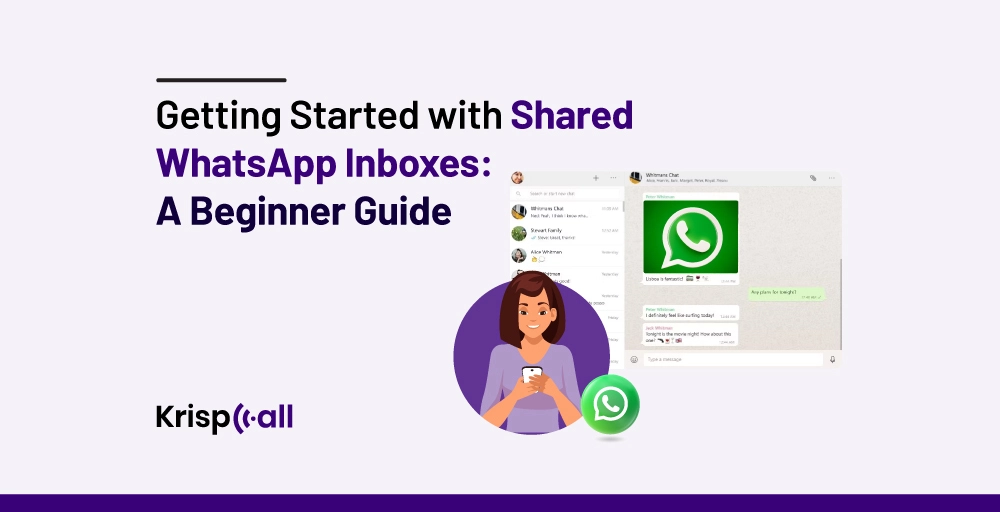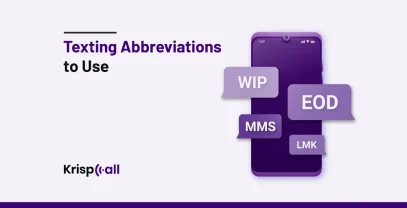It’s no secret that WhatsApp is a part of our daily lives, with over a billion users 🧑🤝🧑 each month.
However, from a business perspective, it can sometimes be difficult to handle many customers with only WhatsApp Business or WhatsApp Web.
On top of that, it becomes even more difficult if you don’t have a capable support team to assist and answer inquiries. This is when you should turn to WhatsApp Inbox, get started, and benefit from it. You can manage all your customer messages from one dashboard without being distracted!
In this article 📑, we’ll explain how WhatsApp works and how you can set up a shared inbox for your business.
🔑 Key Highlights
- WhatsApp shared app is a centralized communication channel.
- Utilizing this can have many benefits for your businesses, such as unified communication, multi-device access, and so on.
- You can create a WhatsApp shared inbox using a dedicated business account and choose the right shared inbox tools.
- Consider pricing, features, and customer reviews while choosing a WhatsApp shared inbox provider.
What is WhatsApp Shared Inbox?

WhatsApp’s shared inbox is a collaborative team inbox that lets your entire team view and respond to customer messages/inquiries over WhatsApp. In other words, it helps your whole team send, receive, and track messages within one dashboard.
Without a doubt, this centralized communication channel can help your team stay organized and more responsive. Moreover, it makes your customer support management easier and more efficient for your business.
How does a WhatsApp Shared Inbox work?
To understand the workings of WhatsApp shared, you need to first understand that this inbox is not directly built into your WhatsApp app. Instead, it is operated by combining it with the WhatsApp Business Application Programming Interface (API). But before that, you need to have access to a WhatsApp Business API number through a provider.
Also, with shared WhatsApp, your messages are routed to the shared inbox platform, where your team members can easily:
- Assign tasks,
- Leave internal notes, and
- Track message status.
Lastly, through this API, your businesses can connect with WhatsApp accounts to a platform that offers more features than the standard WhatsApp application.
What are the benefits of WhatsApp Shared Inbox?
There are many benefits of using Shared WhatsApp inboxes in business organizations as well as sales representatives. Here are some of them:
Enhanced Collaboration

Now, you don’t have to worry about who should respond to your customer calls or text messages. This is all possible with the help of a shared inbox.
Through it, your multiple team members can easily have access, manage chats, and have a smooth conversation within a single platform. Also, with its real-time collaboration, you can easily resolve customer issues in no time.
This not only ensures great teamwork but also makes sure that your important messages aren’t missed.
Improves Customer Service
The shared WhatsApp inbox helps your sales, support, and marketing teams stay in touch with customers. As a result, this ability helps to resolve situations quickly and smoothly, thereby enhancing satisfied customers.
However, to deliver a great customer experience, a shared inbox can be an important tool for businesses.
For instance, customers may contact you via WhatsApp to inquire about product availability. With a shared inbox, your team members will receive an immediate notification of messages, and they can act on them as needed.
Unified Communication

There’s no doubt that a shared inbox helps to centralize all your WhatsApp conversations. This means that you don’t have to use different apps and platforms to manage customer communications. Due to its unified view, you can track interactions and customer sentiment. This is where you can get an overview of your customer needs and enhance engagement.
Sort Conversations with Labels
As a business owner, a Shared WhatsApp inbox is used for labeling and tagging user and client messages. This allows you to categorize and prioritize the conversations based on their urgency. It not only helps you organize your workflow efficiently but also provides the appropriate services.
For instance, adding labels like “potential upsell”. You can then assign it to a team member who is skilled in upselling your products.
Moreover, you can easily track ongoing support issues, find specific inquiries, and so on. This also ensures that you don’t have to waste time searching for one chat that you forgot about.
Multidevice Access
WhatsApp Business API makes the Shared Inbox more accessible and flexible. You can have conversations through multiple devices at the same time. Due to its flexibility, you and your team can work from anywhere utilizing available devices ( desktop computer, laptop, or even a mobile phone).
Therefore, with this multi-device access, customer support is not dependent on any one device or person. In addition, it prevents communication from getting slowed down.
Quick Response Time
A major indicator of customer satisfaction is the Turnaround Time (TAT) on messages. Also, customers are more likely to prefer organizations with prompt service teams.
Using a Shared Inbox makes it easy to manage message threads together, significantly reducing response times. Also, by maintaining pre-written templates for frequently asked questions or common requests, you can respond quickly to customers.
Some WhatsApp Inbox tools allow you to manage multiple WhatsApp numbers simultaneously, which makes customer service really convenient.
How to Create a WhatsApp Shared Inbox?
Different Shared Inbox tools have different functionalities. But, setting up the tools is a straightforward process.
1. Use a Dedicated Business Account
In order to use Shared Inbox, you must have a WhatsApp Business account. You should create and set up an account if you don’t already have one.
2. Choose a Shared Inbox Tool
Shared Inbox features are available in a variety of tools. Select the one that meets the needs of your business. Some prominent tools, like KrispCall, provide cloud telephony features, seamless integration, and additional benefits. So once you’ve purchased it, connect your WhatsApp Business account with the tool.
3. Configure Settings
Once the tool is integrated with your account, configure how you wish to use it. This includes:
- Set up access for team members
- The ability to customize labels and tags
- Establish rules for prioritizing messages
- Assign responsibilities and roles to team members
4. Train Your Team
Provide comprehensive training on how to use the WhatsApp Shared Inbox. You should ensure that each team member understands how to use the interface, assign messages, and collaborate efficiently. In addition, make sure they understand the meaning of the conversation tags and labels along with how to use them.
5. Monitor and Optimize
Once your team has started using Shared Inbox, monitor its performance. Keep track of response times, feedback from customers, and overall workflow. To optimize processes, you can use the analytics feature.
What are the things to consider while choosing WhatsApp Shared Inbox Provider?
The things to consider while choosing WhatsApp Shared Inbox Provider are:
Pricing Plan
Shared inbox providers offer many pricing tiers, often based on features or message volumes. So consider your business and expected usage to determine the most suitable plan. Also, you can use their free trials and demos. Lastly, you should see if there are any hidden fees or not.
Easy of Use
Look for an intuitive interface with clear instructions so your staff can use it in a minimal training session. Also, analyze if the provider offers a mobile app for on-the-go access and management of WhatsApp conversations.
Consider if the platform integrates with other tools you use, such as CRM software or helpdesk systems. This can streamline workflows and improve overall efficiency.
Features
Evaluate whether or not the platform offers features like conversation assignments, internal notes, and pre-written templates. Also to have conversation management you should look for features like labeling, conversation history, and research functionality.
Customer Reviews
Research from online reviews and evaluate what other businesses are saying about different providers. Through this, you can get valuable insights into how the platform can benefit companies similar to yours.
Conclusion
To sum up, there is no doubt that WhatsApp dominates the instant messaging market at the moment. Using WhatsApp’s Shared Inbox tool is a very smart strategy to take advantage of its popularity and leverage its advantages.
With the Shared Inbox, your team can collaborate more effectively, communicate better, and deliver a better level of service to your customers. Your customer satisfaction and service efficiencies will improve, and you will be able to monitor this growth.
Therefore, if you still need to take advantage of the many benefits of a Shared Inbox, then now is the time to do so. In doing so, both of your team as well as your customers, will thank you for it.
FAQs
What does a shared status mean on WhatsApp?
A shared status on WhatsApp is a collaborative way for users to create and share content with their contact groups in a WhatsApp community.
Can I share my WhatsApp chat with others?
Yes, you can share your WhatsApp chat with others in many ways such as screenshots or screen recordings.
What do you mean by WhatsApp Sharing?
WhatsApp Sharing refers to the act of sharing messages, media files, or status updates with other users or groups on WhatsApp.
What do you mean by WhatsApp Team Inbox?
WhatsApp Team Inbox is a collaborative platform for businesses using WhatsApp Business API. It allows multiple team members to manage and respond to customer inquiries and messages received through WhatsApp.





